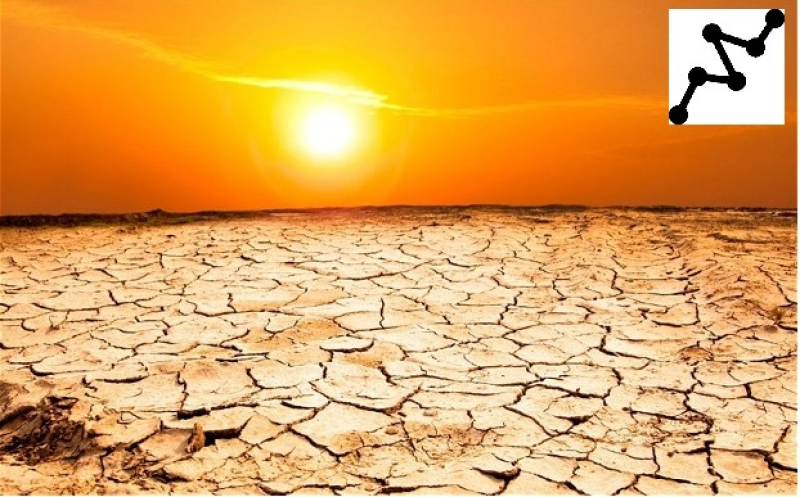Drought
Type of resources
Topics
Keywords
Contact for the resource
Provided by
Years
Formats
Representation types
Update frequencies
status
Service types
-

The Drought Impact Lines dataset highlights areas that have been physically impacted by drought. All drought impact lines have a drought impact label inside of them to express the longevity of the impact. The impact lines are classified using impact labels as follows: S – Short-Term, typically less than 6 months. L – Long-Term, typically more than 6 months. SL – A combination of Short and Long-Term impacts.
-

The Drought Impact Label dataset is used on all drought polygons from D1 to D4 to specify the longitude and magnitude of impacts. Impact labels are often used in association with the Drought Impact Line dataset. The impact labels are classified as follows: S – Short-Term, typically less than 6 months. L – Long-Term, typically more than 6 months. SL – A combination of Short and Long-Term impacts.
-

This series of datasets has been created by AAFC’s National Agroclimate Information Service (NAIS) of the Agro-Climate, Geomatics and Earth Observations (ACGEO) Division of the Science and Technology Branch. The Canadian Drought Monitor (CDM) is a composite product developed from a wide assortment of information such as the Normalized Difference Vegetation Index (NDVI), streamflow values, Palmer Drought Index, and drought indicators used by the agriculture, forest and water management sectors. Drought prone regions are analyzed based on precipitation, temperature, drought model index maps, and climate data and are interpreted by federal, provincial and academic scientists. Once a consensus is reached, a monthly map showing drought designations for Canada is digitized. AAFC’s National Agroclimate Information Service (NAIS) updates this dataset on a monthly basis, usually by the 10th of every month to correspond to the end of the previous month, and subsequent Canadian input into the larger North American Drought Monitor (NA-DM). The drought areas are classified as follows: D0 (Abnormally Dry) – represents an event that occurs once every 3-5 years; D1 (Moderate Drought) – represents an event that occurs every 5-10 years; D2 (Severe Drought) – represents an event that occurs every 10-20 years; D3 (Extreme Drought) – represents an event that occurs every 20-25 years; and D4 (Exceptional Drought) – represents an event that occurs every 50 years. Impact lines highlight areas that have been physically impacted by drought. Impact labels specify the longitude and magnitude of impacts. The impact labels are classified as follows: S – Short-Term, typically less than 6 months (e.g. agriculture, grasslands). L – Long-Term, typically more than 6 months (e.g. hydrology, ecology).
-

Forest Drought Risk Assessment Tool (ForDRAT) provides estimates of stand-level drought risk for various BC tree species (Interior only at this point). Drought risk estimates are provided across different biogeoclimatic units and relative soil moisture regimes for both current and future climates. The data are currently provided in a spreadsheet, with the following columns: 1. BGC: Biogeoclimatic zone, subzone and variant. 2. Period: Data are provided for three historical periods: (i) 1961-1990 climate normal period; (ii) 1971-2000; and (iii) 1981-2010. Projected drought risk is provided for three future periods: (i) 2020 (2011-2040); (ii) 2050 (2041-2070); and (iii) 2080 (2071-2100). 3. SMR_text: Text description of relative soil moisture regime. 4. SMR: Integer code of relative soil moisture regime. 5. AET_PET: Mean annual ratio of actual to potential evapotranspiration. 6. The remaining columns provide estimated drought risk by species. Species codes are as follows: (i) Pl = lodgepole pine; (ii) Sx = hybrid white spruce; (iii) Fd = Douglas-fir (interior variety); (iv) Bl = subalpine fir; (v) Cw = western redcedar; (vi) Hw = western hemlock; (vii) Lw = western larch; (viii) Py = ponderosa pine; (ix) Ac = black cottonwood; and (x) At = trembling aspen. More species will be added over time. Details on ForDRAT development are provided in the following resources: DeLong et al. 2022: http://library.nrs.gov.bc.ca/digipub/Tr141.pdf DeLong et al. 2019: https://www.for.gov.bc.ca/hfd/pubs/Docs/Tr/TR125.pdf Foord et al. 2017: https://www.for.gov.bc.ca/hfd/pubs/Docs/En/En119.htm Nitschke and Innes. 2008: https://www.sciencedirect.com/science/article/abs/pii/S0304380007004061?via%3Dihub
-
30-year Average Dry Day Count is defined as the count of the average number of climate days which received less than 0.5 mm of precipitation during the calendar month. These values are calculated across Canada in 10x10 km cells, and are based on average precipitation amounts over a 30-year period (1961-1990, 1971-2000, 1981-2010, 1991-2020). These values are calculated across Canada in 10x10 km cells.
-
Drought is a deficiency in precipitation over an extended period, usually a season or more, resulting in a water shortage that has adverse impacts on vegetation, animals and/or people. The Climate Moisture Index (CMI) was calculated as the difference between annual precipitation and potential evapotranspiration (PET) – the potential loss of water vapour from a landscape covered by vegetation. Positive CMI values indicate wet or moist conditions and show that precipitation is sufficient to sustain a closed-canopy forest. Negative CMI values indicate dry conditions that, at best, can support discontinuous parkland-type forests. The CMI is well suited to evaluating moisture conditions in dry regions such as the Prairie Provinces and has been used for other ecological studies. Mean annual potential evapotranspiration (PET) was estimated for 30-year periods using the modified Penman-Monteith formulation of Hogg (1997), based on monthly 10-km gridded temperature data. Data shown on maps are 30-year averages. Historical values of CMI (1981-2010) were created by averaging annual CMI calculated from interpolated monthly temperature and precipitation data produced from climate station records. Future values of CMI were projected from downscaled monthly values of temperature and precipitation simulated using the Canadian Earth System Model version 2 (CanESM2) for multiple RCP radiative forcing scenarios. Multiple layers are provided: Climate moisture indexes are shown across Canada for a reference period from 1981-2010. Future projections using RCP 8.5 are given for three different time periods: 2011-2040; 2041-2070; 2071-2100. Future projection using RCP 2.6 given for time period: 2071-2100
-
Agriculture is an important primary production sector in Canada. Agricultural production, profitability, sustainability and food security depend on many agrometeorological factors, including drought. The Canadian Drought Outlook predicts whether drought across Canada will emerge, stay the same or get better over the target month. The drought outlook is issued on the first Thursday of each calendar month and is valid for 32 days from that date. This series of datasets has been created by AAFC’s National Agroclimate Information Service (NAIS) of the Agro-Climate, Geomatics and Earth Observations (ACGEO) Division of the Science and Technology Branch. The Canadian Drought Outlook maps are generated using Environment and Climate Change Canada’s (ECCC) Global Ensemble Prediction (GEPs) forecast data. Agroclimate indices, such as the Standard Precipitation Index (SPI), the Standard Precipitation Evaporation Index (SPEI), and the Palmer Drought Severity Index (PDSI) are calculated using the GEPs forecast data. These indices are then combined with the current Canadian drought assessment to predict future changes in drought.
-

Polygons representing areas vulnerable to heavy rains, heat waves, destructive storms, droughts, and floods. Vulnerability corresponds to the propensity or predisposition of a system (community, infrastructure and natural environment) to suffer damage caused by the manifestation of a climatic hazard. It varies according to the nature, extent and pace of the evolution of the event as well as the variation in the climate to which the system is exposed, the sensitivity of this system and its capacity to adapt. The [Climate Plan 2020-2030] (https://portail-m4s.s3.montreal.ca/pdf/Plan_climat%2020-16-16-VF4_VDM.pdf) aims, among other things, to improve urban planning and regulatory tools. Montréal has thus committed to updating the climate change vulnerability analysis, including the heat island map, carried out as part of the 2015-2020 Agglomération de Montréal Climate Change Adaptation Plan and to integrating it into the next urban and mobility plan. In addition, in order to take stock of the evolution of the Climate Plan, the City of Montreal annually publishes an [accountability report] (https://montreal.ca/articles/plan-climat-montreal-objectif-carboneutralite-dici-2050-7613) of its 46 actions as well as its eight indicators, including the state of the various climate hazards illustrated by vulnerability maps. The data can also be consulted on the [interactive map of vulnerabilities to climate hazards in the Montreal agglomeration] (https://bter.maps.arcgis.com/apps/webappviewer/index.html?id=157cde446d8942d7b4367e2159942e05).**This third party metadata element was translated using an automated translation tool (Amazon Translate).**
-

This is a map of current snow basin indices across British Columbia. Snow basin index mapping is based on analysis from the River Forecast Centre, and is meant to accompany the Snow Conditions and Water Supply Bulletins that are published for data from January 1st, February 1st, March 1st, April 1st, May 1st, May 15th, June 1st and June 15th each year. Snow data collection is managed by the Ministry of Environment and Climate Change Strategy's Snow Program.
 Arctic SDI catalogue
Arctic SDI catalogue